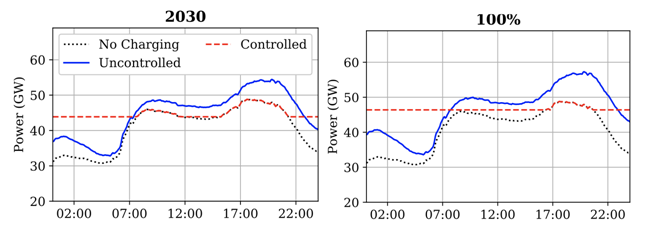At Home or in Forecourts: The Challenges of Public vs Private Charging Infrastructure
Written by Constance Crozier
The rapid adoption of electric vehicles (EVs) can contribute significantly to our decarbonization goals [1]. However, there are concerns about the impacts that the installation of charging infrastructure will have on both power transmission and distribution systems [2][3]. The focus of existing studies has been on residential charging – which represents the majority of early adopter charging sessions.
However, the number of public charge points has grown significantly – with more than 34,000 public chargers now available in the state of California. It is now feasible in some areas to own an EV and charge exclusively using public chargers. This article will investigate the benefits and drawbacks of residential and public charging, considering three perspectives: the network infrastructure, operation, and consumer equity.
Figure 1. The three impact perspectives considered and their relevant factors.
Power Infrastructure
It is estimated that more than 85% of electric vehicle charging takes place at home[4]. Until very recently it was not feasible to own an EV without access to a private charging point (either at home or work). Even given the recent increase in the availability of public charging, consumers gravitate towards the convenience of home charging. Consumers have a variety of options when it comes to charger installation (summarized in Table 1). These vary from charging from a standard outlet to installing a 3-phase charging box.
Table 1: The power rating and charging potential of various home charging options. *Assuming the efficiency of a 2023 Nissan Leaf.
These loads are high compared to existing household appliances (currently only heating and air conditioning units are comparable). However, charging loads are more problematic because they are on for hours at a time and typically coincide with the existing residential peak demand [3]. Residential buildings are connected to low-voltage distribution networks which incur relatively high losses [5], meaning costly distribution system upgrades may be necessary [2]. On the other hand, public chargers are typically connected to higher voltage networks, meaning network upgrades are less likely. Additionally, the number of chargers needed is significantly lower compared to the private charging paradigm – although intelligent placement of these chargers is an area of ongoing research [6].
Network Operation
From the perspective of the network operator, residential vehicle charging presents both a challenge and an opportunity. Although charging demand largely coincides with existing peak demand, typically vehicles remain parked at home for much longer than is necessary to charge them. This means that if appropriately incentivized, vehicle charging demand could be shifted to the overnight period (where demand is currently low). This is demonstrated in Figure 2, which shows the simulated charging demand of Great Britain with both controlled and uncontrolled charging; with controlled charging any increase in peak demand can be avoided.
Figure 2. Simulated power demand in Great Britain with controlled and uncontrolled charging [3].
In contrast, public chargers have very little flexibility. With fast chargers (50-250kW), consumers typically wait for their vehicle to charge and as such would be extremely inconvenienced by delayed charging. Some lower-rated public chargers (often referred to as destination chargers because they are placed at locations consumers are likely to spend one hour or more) have some flexibility. However, in these cases consumers are often charged per time spent at the charger (rather than per kWh) and delaying charging can result in queuing – other consumers arriving and finding the chargers unavailable. Additionally, the higher rating of these chargers can make operation more challenging as these chargers increase the volatility of demand – a small number of co-incident fast chargers can cause 1MW step changes in load.
Consumer Equity
The ability to charge a vehicle at home is a privilege; without access to off-street parking, consumers are not able to charge at home. This disproportionately affects renters, who often do not have private garages and those who do are limited to level 1 charging due to the inability to install a charging box. In the US, homeowners are statistically older, richer, and whiter than the general population[7] – meaning that marginalized communities are disproportionately disadvantaged.
This issue is further exacerbated by the fact that residential charging is cheaper. At home, a consumer can expect to pay $0.15/kWh while public charges average $0.30-0.60/kWh. This issue is further compounded by incentives offered – e.g. the UK government used to subsidize the installation of home chargers, and some utilities offer special tariffs to those with electric vehicle chargers. Furthermore, the required costs of distribution network upgrades are often socialized in an increase to all consumers’ electricity prices.
Public chargers represent a much fairer investment as all electric vehicle owners can access them. However, care needs to be taken to place chargers so as to prioritize those communities which do not have access to private charging; the converse is currently being seen in urban areas such as NYC [8].
Conclusion
The vast majority of observed charging is currently residential. This model allows consumers access to a dedicated charger and has significant benefits in terms of network operation – as individual loads are smaller and demand flexibility can be exploited. However, access to this mode of charging is inequitable and distribution networks may require costly upgrades. Public charging, on the other hand, results in more efficient use of infrastructure and provides charging options to those who cannot charge at home. A mix of both charging modes can balance the benefits of flexible residential charging, with the volatility of fast public chargers. However, public investments should focus on increasing the access and affordability of public charging points to avoid exacerbating existing inequalities.
References
- Z Hausfather, “Factcheck: How electric vehicles help to tackle climate change”, Carbon Brief, 2019.
- S Elmallah, A Brockway, D Callaway “Can distribution grid infrastructure accommodate residential electrification and electric vehicle adoption in Northern California?” Environmental Research: Infrastructure and Sustainability 2 (4), 2022.
- C Crozier, T Morstyn, M McCulloch, “The opportunity for smart charging to mitigate the impact of electric vehicles on transmission and distribution systems” Applied Energy 268, 2020.
Idaho National Laboratory, “Plugged in: how Americans charge their electric vehicles”, 2021. - C. Crozier, M. Deakin, T. Morstyn, M. McCulloch, Coordinated electric vehicle charging to reduce losses without network impedance information, IET Smart Grid, 2020.
- M. Z. Zeb et al., "Optimal Placement of Electric Vehicle Charging Stations in the Active Distribution Network," in IEEE Access, vol. 8, pp. 68124-68134, 2020, doi: 10.1109/ACCESS.2020.2984127.
- T. Mariotti “Homeowner vs. renters statistics” RubyHome Blog, 2022.
- Hafiz Anwar Ullah Khan, Sara Price, Charalampos Avraam, Yury Dvorkin,”Inequitable access to EV charging infrastructure”, The Electricity Journal, Volume 35, Issue 3, 2022.
This article was edited by Gabriel Ordonez.
To view all articles in this issue, please go to June 2023 eNewsletter. For a downloadable copy, please visit the IEEE Smart Cities Resource Center.

To have the Bulletin delivered monthly to your inbox, join the IEEE Smart Grid Community.
Past Issues
To view archived articles, and issues, which deliver rich insight into the forces shaping the future of the smart grid. Older Bulletins (formerly eNewsletter) can be found here. To download full issues, visit the publications section of the IEEE Smart Grid Resource Center.






